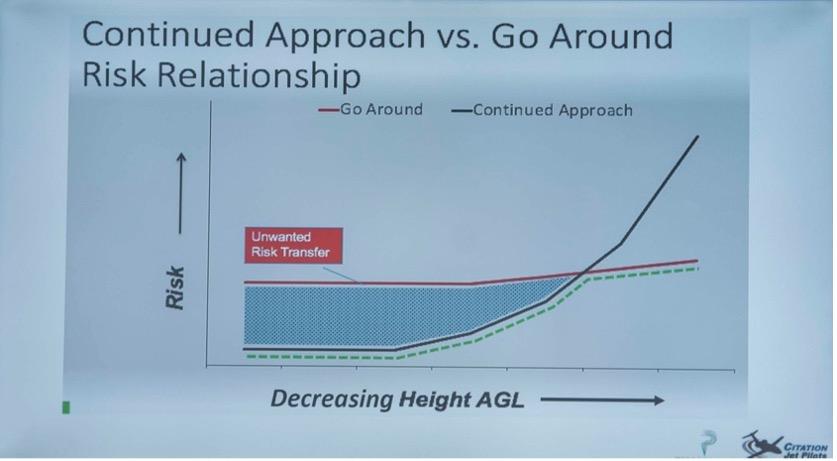
The Citation Jet Pilots (CP) owner-pilots association hosted a briefing about how to improve go-around decision-making at the 2021 NBAA-BACE. The presenter was member Charlie Precourt, a retired NASA space shuttle and astronaut. While the briefing was held at the Single-Pilot Pavilion, Precourt’s presentation cut across all aircraft types and operations.
According to a 2017 Flight Safety Foundation (FSF) study that covered a 16-year period, pilots executed go-arounds only 3% of the time when an approach exceeded stable approach criteria. The study concluded that pilots do not view stable approach criteria as credible and adopt an “I can fix this” philosophy.
Precourt briefly covered the Aug. 15, 2019, crash of a Citation Latitude in Elizabethton, Tennessee, that made national news because its passengers, race car driver Dale Earnhardt, Jr. and family managed to escape the burning wreckage. The pilots exceeded one, two, or three of six of their established stable approach criteria, at least six times during the approach. At one point, the Pilot Flying (PF) asked, “Do I need to go around?” The Pilot Monitoring (PM), his boss, said, “No.” After the accident, both pilots stated the approach was stable.

The FSF study found that most accidents happen during the landing phase of flight, but that most of those are nonfatal. Of the landing-phase accidents that ended in a late go-around attempt, most ended up with fatalities.
As with the case of the Citation Latitude pilots in the 2019 crash, most pilots do not recognize when an approach becomes unstable. The FSF study noted that the more criteria that are exceeded, the more likely pilots are unable to recognize the approach as unstable. We tend to think the risk of a go-around is greater than for a continued approach. But statistics show that while that might be true early in the approach, the risk factor changes when you get lower to the ground. As we continue the approach, we tend to get “tunnel vision” and fixate on the task at hand: landing the aircraft. Our situational awareness decreases, and we become blind to our stable approach criteria.

Precourt advocated a new approach to stable approach criteria, one where you do not have one altitude to evaluate the criteria and make the decision. If at 500 ft., for example, you may tend to think, “Sure, I am a little high, but I’ve got a minute to fix this!” Instead, we should have a point where we evaluate our criteria as a goal, and as crews announce where we are in relation to that goal. We continue to call out deviations and warnings until we arrive at a limit point where we are primed for the go-around decision.
Let’s say, for example, you are indeed stable, and everything goes smoothly. The PM has three callouts. At 1,000 ft., the PM announces, “configured.” At 500 ft., the PM says, “stable.” At 200 ft., the PM says “continue.”
Now let’s says things are not going so well and the PF arrives at the 1,000-ft. point too high. The first callout becomes, “Configured, but high.” If the PF manages to return to the proper glide path but ends up too fast, the 500-ft. call can be, “500 ft., 30 kt. fast.” From that point the PM continues a play-by-play, “400 ft., still 30 kt. fast.” Then, “300 ft., 20 kt. fast.” If still too fast at 200 feet, the callout is “200 feet, go around.” The advantage of this approach is it gives the pilots 300 extra feet to correct things and it primes the crew for the go-around decision. If the pilot does manage to get things back into the stable approach criteria, they continue.
Much has been made of “continuation bias” and the way pilots are prewired to finishing what we start. There is also a lot of literature about “startle factor,” how pilots can find themselves surprised at what they should have predicted. This new stable approach philosophy of goal/warning/limit can be a game-changer. As Precourt concluded his remarks it became obvious that many in the audience experienced an “aha!” moment, realizing this method may be just what they need to avoid becoming one of the 97% who fail to go around from an unstable approach.
